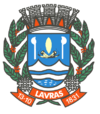Lavras
| Larvas | |||
|---|---|---|---|
| |||
| Nickname(s): Cidade dos Ipês e das Escolas ("City of the Ipês (a tree) and Schools") | |||
 Location of Lavras | |||
| Coordinates: 21°14′42″S 45°00′00″W / 21.24500°S 45.00000°WCoordinates: 21°14′42″S 45°00′00″W / 21.24500°S 45.00000°W | |||
| First mentioned | 1729 | ||
| Town rights | 1831 | ||
| Government | |||
| • Mayor | Marcos Cherem | ||
| Area | |||
| • Total | 564.495 km2 (217.953 sq mi) | ||
| Elevation | 919 m (3,015 ft) | ||
| Population (2012)1 | |||
| • Total | 94 228 | ||
| • Density | 166,92/km2 (43,230/sq mi) | ||
| Time zone | UTC-3 (UTC-3) | ||
| • Summer (DST) | UTC-2 (UTC-2) | ||
| Website | Lavras | ||
Lavras is a municipality in Southern Minas Gerais state, Brazil. Located at an altitude of 900 m, it has an approximate population of 95,000 inhabitants. The area of the municipality is 566.1 km². The average annual temperature is 19.4°C and the average annual rainfall is 1,529.7 ml.
Located near the Circuit of the Waters—a series of spas in the state of São Paulo and Minas Gerais—and the historical cities of Minas, it is connected by highway to the state capital, Belo Horizonte (230 km.), to São Paulo (370 km.) and Rio de Janeiro (420 km.)
History
The settlement of the Campos de Sant'Ana das Lavras do Funil dated from the first half of the 18th century, founded in 1729.[1] The first inhabitants were the Paulista family of Francisco Bueno da Fonseca, leader of a revolt against a Portuguese judge in São Paulo in 1712.[2] Bueno da Fonseca, his sons and other explorers, settled in the region of the rivers Capivari and Grande by the years of 1720[3] or 1721,[4] where they were engaged in the search for gold and in the opening of new roads to the Goiás mines. In 1737 the explorers receive from the Governor Martinho de Mendonça a allotment letter confirming their region occupation, which grew through agriculture and livestock.
The village's rapid growing is attributed to the influence of captain Bueno da Fonseca's family, who changed the parish seat from Carrancas to Lavras in 1760.[5] In 1813 the town was elevated to parish through the dismemberment of Carrancas. On the Imperial period, Lavras obtained its political and administrative emancipation, becoming a municipality in 1831 and city in 1868. After the Proclamation of the Republic, Lavras established itself as a major regional center of Minas Gerais, being the birthplace of Francisco Salles, an important politician of the Old Republic.
University
The city is a university center with one of Brazil's top universities — UFLA - Universidade Federal de Lavras . Founded in 1908 it is well known in Brazil and abroad for its courses in agronomy and veterinary science. Seventy percent of its 305 teachers have Ph.D. degrees. There are 2,673 undergraduate students and 5,884 graduate students, with 546 doing the M.S. and 374 doing the Ph.D. In a recent study, out of 875 schools analysed UFLA was voted the second best in the country in its courses and the first among all federal universities.
Economy
Besides the university, the municipality also bases its economic life on coffee, beans, rice, corn, citrus fruits, and dairy cattle. There are small industries producing clothing, towels, metallurgy and dairy products.
Lavras was a station on the Estrada de Ferro Oeste de Minas, a narrow gauge railway.
References
- ↑ COSTA, Firmino. História de Lavras. In: Revista do Arquivo Público Mineiro. Belo Horizonte: Imprensa Oficial de Minas Gerais. Ano XVI, jan./jun. 1911, pp. 130-131.
- ↑ NÉMETH-TORRES, Geovani. De Parnaíba às Lavras do Funil: Subsídios para a História das Origens de Lavras, 1712-1729. Lavras: Edição do Autor, 2012.
- ↑ SAINT-ADOLPHE, J. C. Milliet de. Diccionario Geographico, Historico e Descriptivo, do Imperio do Brazil. Paris: J. P. Aillaud, 1845, t. I, pp. 556-557.
- ↑ SÃO PAULO, Arquivo do Estado de. Publicação Oficial de Documentos Interessantes para a História e Costumes de São Paulo. São Paulo: Aurora, 1895, v. 4, pp. 27-33.
- ↑ NÉMETH-TORRES, Geovani. Os 250 Anos da Paróquia de Sant'Ana: Uma História da Igreja Católica em Lavras. Lavras: Edição do Autor, 2010

